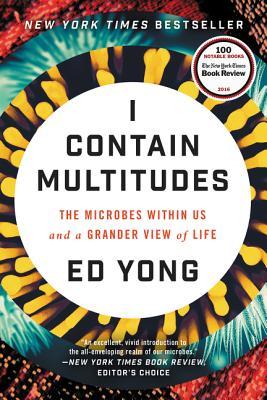 I Contain Multitudes: The Microbes Within Us and a Grander View of Life by Ed Yong
I Contain Multitudes: The Microbes Within Us and a Grander View of Life by Ed Yong Published by Ecco on January 16, 2018 (first published 2016)
Source: Purchased
Genres: Science, Non-fiction
Pages: 368
Format: Paperback
Purchase at Bookshop.org or Purchase at Amazon
Add on Goodreads

Joining the ranks of popular science classics like The Botany of Desire and The Selfish Gene, a groundbreaking, wondrously informative, and vastly entertaining examination of the most significant revolution in biology since Darwin—a “microbe’s-eye view” of the world that reveals a marvelous, radically reconceived picture of life on earth.
Every animal, whether human, squid, or wasp, is home to millions of bacteria and other microbes. Ed Yong, whose humor is as evident as his erudition, prompts us to look at ourselves and our animal companions in a new light—less as individuals and more as the interconnected, interdependent multitudes we assuredly are.
The microbes in our bodies are part of our immune systems and protect us from disease. In the deep oceans, mysterious creatures without mouths or guts depend on microbes for all their energy. Bacteria provide squid with invisibility cloaks, help beetles to bring down forests, and allow worms to cause diseases that afflict millions of people.
Many people think of microbes as germs to be eradicated, but those that live with us—the microbiome—build our bodies, protect our health, shape our identities, and grant us incredible abilities. In this astonishing book, Ed Yong takes us on a grand tour through our microbial partners, and introduces us to the scientists on the front lines of discovery. It will change both our view of nature and our sense of where we belong in it.
In general, microbes are not something I spend much time thinking about. I wash my hands to hopefully keep away germs, take my probiotic pill, and that’s about it. I’m not one of those people who carry around a can of Lysol, which apparently can be a good thing. “So, here’s the irony: toilets that are cleaned too often are more likely to be covered in faecal bacteria.” I Contain Multitudes by Ed Yong made me think about the vast array of microbes in our world – helpful, harmful, and ones that can be both or neither.
Yong touches on the evolution of microbes; the history of microbiology; symbiotic relationships among microbes; symbiosis between microbes and higher organisms; dysbiosis (unbalanced microbiomes that harm their hosts); how scientists study and identify microbiomes; research studies aimed at seeding hospitals and buildings with ‘good microbes’; and much more. He writes in an entertaining, easy to understand way. He makes microbes fun.
My family is probably glad I’ve finished reading I Contain Multitudes. I have a tendency, especially when I’m reading non-fiction, to share bits and pieces of what I learn with them, like the adorable bobtail squid on Hawaii that glows thanks to a luminous bacteria or how microbes affect the health of coral reefs. The number of creatures that have symbiotic relationships with microbes is simply staggering and how many daily life tasks the microbes perform, help them perform is astounding.
I won’t remember many specifics from this book, even though he gives a lot. The take-away for me is that microbes can be incredibly helpful and impossible for many creatures to live without, digesting food, providing protection, potentially solving medical issues. They can also be incredible damaging, destroying forests or causing diseases. It also seems like the broader the variety of microbes we are exposed to, the better, the more likely the good ones will take root. While sterile may be best in some circumstance, that’s far from true in all circumstances.
This was first foray into science non-fiction in quite a well, and I have to say that I’m glad I read it. I learned a lot and it gave me a new way to see the world. “We cannot fully understand the lives of animals without understanding our microbes and our symbioses with them.”

I would probably drive everyone crazy with facts from that book if I read it too. It sounds interesting.
I was surprised by how much I enjoyed it.
For non fic this does sound interesting
I did take me a while to read, but it was good.
Wow…you are really reading some unusual books! This one would scare me!
I like books like this but rarely read them anymore.